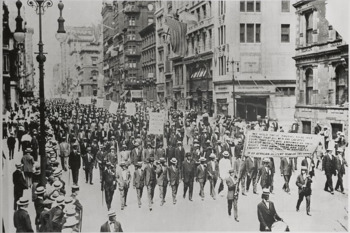Hutchens Chew Bishop facts for kids
Quick facts for kids
Hutchens Chew Bishop
|
|
|---|---|
| Born | 1859 |
| Died | 17 May 1937 (aged 77–78) |
| Occupation | Priest in The Episcopal Church |
The Reverend Dr. Hutchens Chew (H.C.) Bishop (1859 – May 17, 1937) was an important Episcopal priest. He spent most of his life working in New York City. He was the leader, called a rector, of St. Philip's Episcopal Church in Harlem for 47 years. This church is the oldest Black Episcopal church in New York. It was started by people who wanted to end slavery, known as abolitionists, in 1819.
Early Life and Family Background
Hutchens Chew Bishop was born in Maryland in 1859. His parents were William Henry Bishop III and Elizabeth Chew Bishop. His family had a long history with the Episcopal Church. His grandfather, William Bishop, was one of the richest men in Annapolis. His great-grandmother, Charity Folks, was a notable woman from Annapolis. She lived during a time when some people were enslaved, but she later became a free woman who owned property.
Dr. Bishop's family was well-known in the Black community. His father and older siblings helped start the second Black Episcopal church in Baltimore in 1867. This church, the Chapel of St. Mary the Virgin, became a church for many respected Black families in the city.
Education and Early Career
Hutchens Chew Bishop made history as the first Black student to be accepted into the General Theological Seminary in New York. He finished his studies in 1881. He became a priest on April 24, 1882. In 1883, he became the rector of St. Mark's Church in Charleston.
Dr. Bishop was different from many other ministers of his time. He grew up in a city, not the countryside. Also, he and his parents were born free. As the first Black student in his theology school, he studied alongside white students.
In 1885, he married Estelle Gilliam. She was from a very respected Black family in New York. She was also a member of the St. Philip's congregation.
Leading St. Philip's Church in Harlem
On January 1, 1886, Dr. Bishop became the rector of St. Philip's Church in New York City. He stayed in this important role for 47 years, until 1933. His son, Shelton Hale Bishop, later became the rector of the same church. He also had a very respected career.
In 1910, Dr. Bishop worked with a well-known Harlem businessman, John E. Nail, to buy land for St. Philip's Church. It was hard for Black people to buy property from white sellers at that time. So, Dr. Bishop pretended to be white to complete the sale. He bought the land for the new St. Philip's Church building. He also bought 10 apartment buildings. The famous architect Vertner Woodson Tandy, who was the first Black registered architect in New York, designed the new church building for Dr. Bishop.
In 1917, Dr. Bishop was the president of the historic Silent Parade. This was a large protest march. Another New York minister, Rev. Dr. Charles D. Martin, was the secretary. Dr. Bishop's church, St. Philip's, was the main place where the parade was planned. He marched alongside other important leaders like W. E. B. Du Bois, James Weldon Johnson, and businessman John E. Nail.


